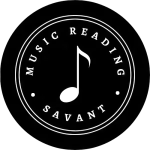The tempo ranges for each of the tempo markings in music can really vary.
While there is nothing set in stone defining the exact speed of each tempo marking, we do have some rough guidelines to help us make decisions.
Please note that you can find several lists of ranges that are not exactly the same, but they are fairly close in range.
Use this list as a guide and only your guide. It is up to you to decide what tempo fits best with the style of music you are playing.
| ✅ The best self-study music theory book loved by all my readers and students. |
List of Tempo Ranges
Tempo Marking Beats per Minute
Grave 40-50 BPM
Largo 50-55 BPM
Larghetto 55-60 BPM
Adagio 60-70 BPM
Andante 70-85 BPM
Moderato 85-100 BPM
Allegretto 100-115 BPM
Allegro 115-140 BPM
Vivace 140-150 BPM
Presto 150-170 BPM
Prestissimo 170+ BPM
Notice how the tempo markings suggest a range of tempos. There is not anyone tempo set in stone for each tempo marking.
Why is this? Because tempo markings were created well before metronomes were ever invented.
Only now do we have the capacity to define tempos a little more with the handy development of metronomes.
Now science is helping us get a better guideline as to what each of these markings mean.
What are Beats per Minute?
Beats per minute (BMP) literally describes how many steady beats fit in one minute of time.
A metronome is set at a certain number of beats per minute to help a musician play steadily and accurately at the appropriate tempo. Sometimes our foot can lie when we tap it to hold a steady beat, but our metronomes never do.
You can often find tempo ranges marked on the back of metronomes to use as a guideline for different tempo markings. Again, every metronome will have a slightly different list, so use your best judgment.
How Do I Decide What the Best Tempo Is?
All I can say is try a few different metronome markings to find out. Tempos are all relative and not an exact science.
You will need to play around with your metronome a little to find out what will work best for your music.
For example, if I play a march that is marked allegro, I may find that 115 BPM may be too slow while 140 BPM is way too fast.
I might settle in at 120 BPM as a perfect tempo for the piece. Use your musical intuition to help you decide.
As you can see, tempo ranges are all varying for each tempo marking you find in your music.
It really is a range and not an exact marking on your metronome. Use the list above as your guideline and only your guideline.
Compare it to what is listed on the back of your metronome. Decide for yourself what ranges fit each of the tempo markings best for each style of music.
Recommended Music Theory Books
✅ The best self-study music theory book loved by all my readers and students.

Thanks for the guide. It’s ANOTHER but useful guide when comes to decide the bpms, in particular the distinction between Allegretto and Allegro.
But I have a question, still unsolved, wherever I try to look: how can “La campanella” by Hamelin have a tempo of 1/8 = from 176 to 192 when the indication is “Allegretto comodo”?
Is there a general indication that associates a “bpm scale” to a century or Author? It seems to me that tempos have “speed up” over centuries. Moderato was 80, now is 120…